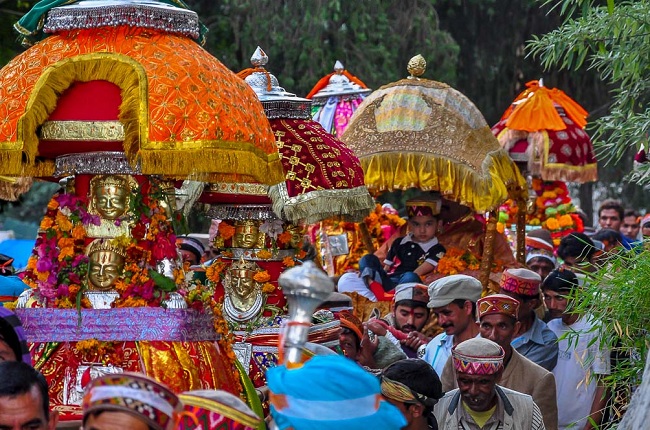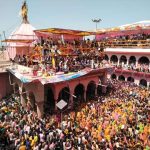A week-long festival celebrated in majestic style in northern India, Kullu Dussehra is one of the most popular events of Himachal Pradesh, signifying the victory of good over evil. It draws travelers from distant parts of the globe. It is held in the Dhalpur maidan at Kullu in Himachal Pradesh state.
Kullu is known for its beautiful gorges, wondrous waterfalls, chatty mountain stream, and ancient temples which are certainly going to enthrall you, especially during the Kullu Dussehra festival.
Dating back to the 17th century, Kullu Dussehra starts on Vijaya Dashmi and lasts for seven days in the month of October. It is a lovely blend of rich culture, history, and ritual. This festival is only held to celebrate the success of good over evil.
While music and color create a peaceful ambiance, thousands of people gather on the first day of celebration to pay respect to Lord Raghunath. The first day is started with a huge celebration and on this day the statue of Lord Raghunath is installed on a beautifully designed chariot, which is graced with the presence of village gods and goddesses, is pulled by ropes by the locals from its place to different sites across the Maidan.
The festival days are celebrated with great devotion, and many an individual take participate in singing and dancing during the festival. The fair is fulfilled with the burning of Lanka. On the last day of the festival, the chariot is brought by the banks of Beas River where a mass of wood grass is burnt, signifying the burning of Lanka.
History of Kullu Dussehra
 According to mythology, Kullu was under the control of Raja Jagat Singh in the 16th century. At some point, he got to know that someone by the name of Durgadutt had charming pearls. The Raja tried everything to have that pearls.
According to mythology, Kullu was under the control of Raja Jagat Singh in the 16th century. At some point, he got to know that someone by the name of Durgadutt had charming pearls. The Raja tried everything to have that pearls.
Though Durgadutt made him clear that the information was not correct, all his requests were hopeless. He offered him the last chance of giving the pearls but he did not and as a result, Durgadutt set himself and his own family on fire and cursed the Raja Jagat Singh for his brutality. Thereafter, he felt guilty and took advice from a Brahmin.
The sacred man asked him to get back the statue of Lord Raghunath from the kingdom of Lord Ram. Worried, the Raja decided to send the Brahmin to Ayodhya.
One day, he took the statue and started his way back trip to Kullu. When the locals of Ayodhya came to know that the idol of Lord Raghunath was missing, they left in search of him. The people found the Brahmin with Raghunath on the banks of the Saryu River. Then he started telling them the story of the king.
When the people picked up the idol while heading towards Ayodhya it was heavy, but to their amazement, the idol became light as they moved to Kullu. When the Brahmin reached Kullu, the idol of Raghunath was installed. Subsequently, the king had a sip of the Charan-Amrit of the statue of the Raghunath and the curse was repealed. This myth is associated with Kullu Dusshera.
Must Read:Telangana’s Dasara: Festival of Flowers, Bathukamma
How Kullu Dussehra is Celebrated?
 The celebrities are a little different as on the day of Dussehra, the devotees in Kullu carry out a procession wherein they carry the idols of different gods on their heads and meet Lord Raghunath (Lord Ram) in the temple. Hundreds of gods are brought on the temple grounds on the day of Dussehra, including Hadimba (the prime deity of the Kullu kings) and Jamlu Rishi (the deity of Malana village) among others. During this seven-day festival, the residents indulge in various entertaining cultural activities such as dancing, singing, and other cultural programs.
The celebrities are a little different as on the day of Dussehra, the devotees in Kullu carry out a procession wherein they carry the idols of different gods on their heads and meet Lord Raghunath (Lord Ram) in the temple. Hundreds of gods are brought on the temple grounds on the day of Dussehra, including Hadimba (the prime deity of the Kullu kings) and Jamlu Rishi (the deity of Malana village) among others. During this seven-day festival, the residents indulge in various entertaining cultural activities such as dancing, singing, and other cultural programs.
The festivities not only attract locals but also a number of international travelers, who visit Kullu to witness the grand celebrations. All these activities are performed in proximity to the gorgeous Beas river. On the last day, a pile of wood is collected and devotees put fire to it; the practice is symbolic of destroying and burning the home of Ravana, Lanka.
Kullu Dussehra where hundreds of Gods and Goddesses decked up in their finery coverage with their retinue for week-long festivity at Dhalpur grounds is one of its kind. The folk flavor of the festivity, rituals, and traditions here makes it totally different from Dussehra celebrations elsewhere in the country. Decorated with colorful raths and moharas amid the beat and rhythm folk instruments, Dhalpur ground during Dussehra presents an amazing scene.
Traditions involved in Dussehra
 The three important days of the Dussehra are the appearance of Thakar (Raghunathji), Muhalla (penultimate day of Dussehra), and Lanka Dahan (Burning of Lanka). Actually, the Dussehra starts on the first day of the Navratra. On that day special worship is offered to Raghunathji at Sultanpur. In the earlier days Adi Brahma of Khokhan, Gohari devata of Dhalpur, Durvasa of Palgi, Narad of Ninu also used to join this worship. Now only Gohri of Dhalpur comes in the performance.
The three important days of the Dussehra are the appearance of Thakar (Raghunathji), Muhalla (penultimate day of Dussehra), and Lanka Dahan (Burning of Lanka). Actually, the Dussehra starts on the first day of the Navratra. On that day special worship is offered to Raghunathji at Sultanpur. In the earlier days Adi Brahma of Khokhan, Gohari devata of Dhalpur, Durvasa of Palgi, Narad of Ninu also used to join this worship. Now only Gohri of Dhalpur comes in the performance.
The devtas coming from the distant areas like from the Outer Saraj and Inner Saraj start their journey days before and on reaching Kullu they pay respect to Raghunathji at Dhalpur and settle down at their respective places allotted to them. In the morning on the tenth of the bright half of Aswin, all the devatas come out from their tents and proceed with the band of their musicians towards the temple of Raghunath.
They are offered, on behalf of the temple, a phagu (a long yellow colored piece of cloth). Then they come to the praul (the main gate of Tharah Karudu in the palace). The main deities stay there for the day’s procession. The remaining deities proceed to Dhalpur for participation in the reception of the procession.
Hidimba is not present among these deities. She halts at Ramshila, at the head of Akhara Bazar, till the messenger from the Raja with a staff of silver reaches to receive her. Devi Hidimba then goes with the messenger of the Raja first to the temple of Raghunathji and then comes to the palace.
There at the Praul of Tharah Karadu, Rajpurohit, the royal priest, in the presence of the Devi, causes the Raja to offer worship to the flags, fans, and other articles and arms. Then the worship is offered to Naupat (dudumbhi) and the horse of Nrisingh. This is called ghora- pujan (horse-worship). The Raja then gives one arrow each to four persons.
The person of the zodiac sign of Scorpion goes in the eastern direction, that of Cancer to the west, that of Aries to the south, and that of the Libra go towards the north. They don’t return. It is noteworthy that Angad, the leader of the force sent by Shri Rama, who was sent towards the southern direction in search of Sita, belonged to the zodiac sign of Aries.
[video_ads]
[video_ads2]
You can send your stories/happenings here:info@religionworld.in









